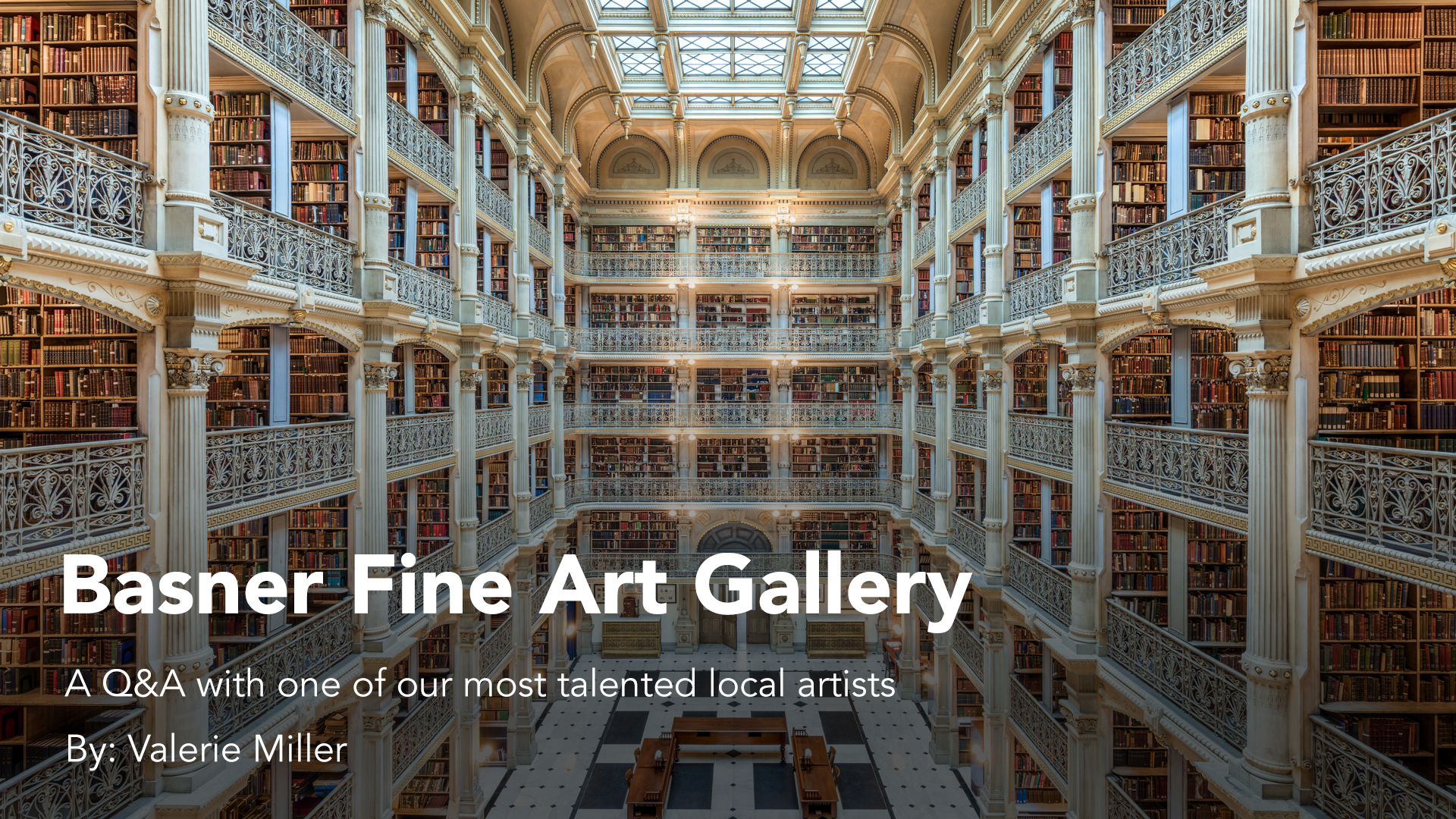
Vegas Legal Magazine: Can you talk about what inspired you to open a gallery in Las Vegas?
Mario Basner: Las Vegas has been my home since 2006. When I was ready to release the “Beelitz Sanatorium Series” in 2017, I thought long and hard about the best way to show this profound material. Although I had representation interest from world renowned galleries, it was more important to me at that moment to share this extraordinary experience with an audience in its entirety. This required a great deal of wall space, which led me to open the gallery under my own name. The initial plan was for a 6-week exhibition at Tivoli Village and we received an incredible reaction from the Las Vegas community. The gallery has become a staple of Las Vegas art & culture, a hub for philanthropy and I am proud to say that we have been serving our collectors for 7 years now.
VLM: Please discuss the evolution of the arts scene in Las Vegas over the years that you have been here.
MB: In my 18 years in Las Vegas, the arts scene has certainly refined itself and I think it holds tremendous promise for the future. Especially in the last years pre-Covid, I noticed a lot of exciting developments and enthusiasm about the Arts District, a proposed Art Museum and other innovative venues that are diverse and passionate, i.e. Core Contemporary. The pandemic slowed down that momentum but I am confident that the future of art in Las Vegas remains bright.
VLM: How did the pandemic COVID -19 shutdowns affect your business? How were you able to recover?
MB: The gallery only closed for 2 months in 2020 but despite being open, it was very challenging to deal with an unprecedented situation. We made a conscious decision early on to use our time to create progress regardless of uncertainty and low foot traffic. We gave the gallery a facelift and a new fresh look; we created a completely new website, put e-commerce capabilities in place and placed 30 ft building wraps on the building to create visibility from Rampart Blvd..
VLM: What artist inspired you to do what you are doing today?
MB: I would have to credit the German artist Gregor Toerz primarily. His story and dedication to his own work left me empowered to follow my own dream and develop the stamina to accept significant risk, especially when we first opened the gallery.
VLM: If you could choose what would come to Las Vegas next, what would be on your wish list?
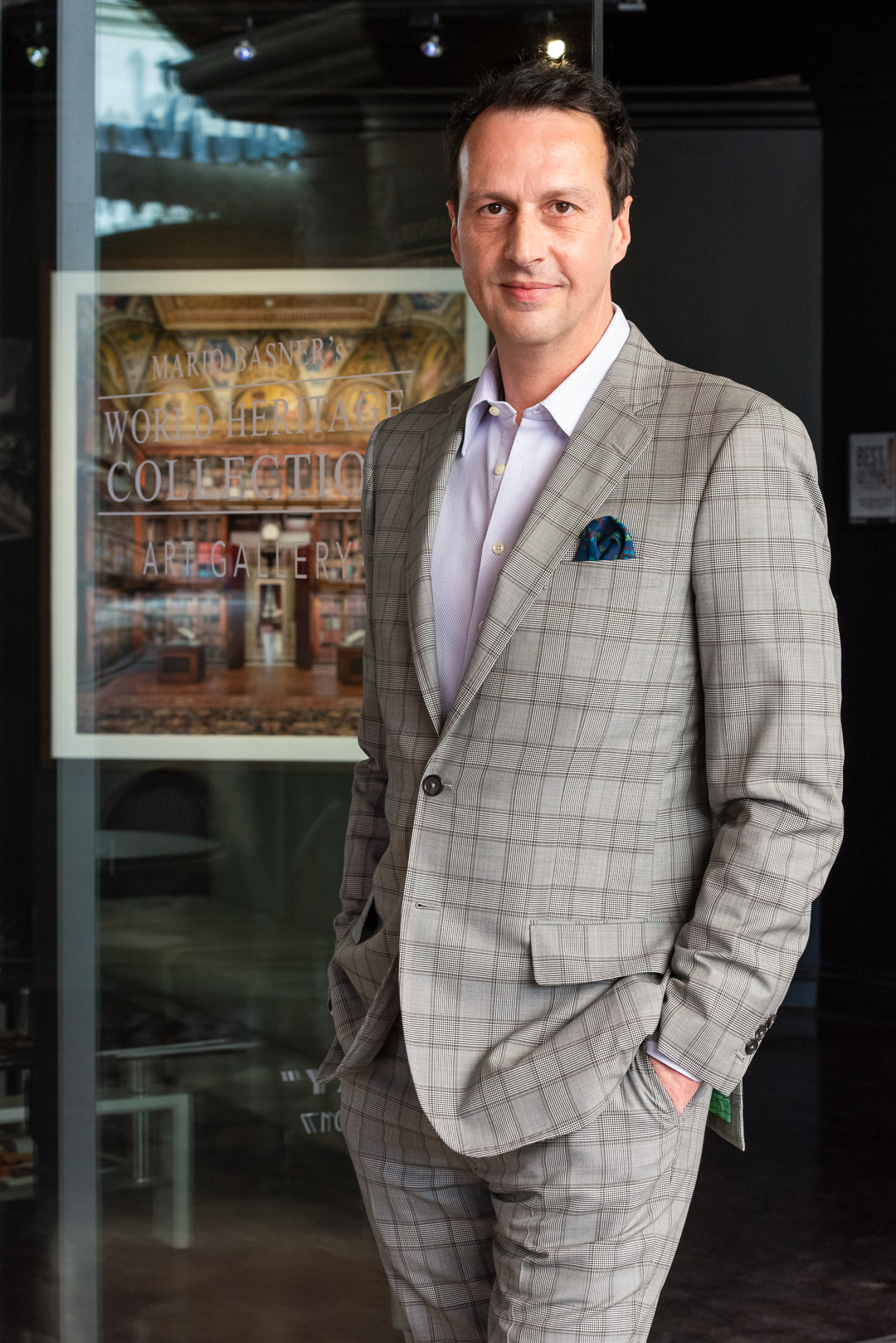
Mario Basner stands in front of his art gallery at Tivoli Village in Las Vegas.
MB: I hope the Art Museum might turn into a reality in the foreseeable future. It will be an important catalyst to make Las Vegas an arts destination over time.
VLM: Lately, the issue of “stolen art” has been in the news. Contested artwork has been removed from Chicago’s Art Institute and museums in places like New York, after claims it was stolen during World War II. How big do you think this issue is going to become going forward?
VLM: Does the Southern Nevada community support the arts as much as is needed for artists to survive?
MB: This is a loaded question. On one hand I believe that in order to be successful, it is the artist’s responsibility to put themselves out there and find their audience. On the other hand, without the support of the community that can be a very difficult task. In my experience, it required very hard work to establish myself and remain consistent in that pursuit, working 80 hours a week and believing in myself and my work. Once I applied myself with this level of dedication, I received a great deal of recognition from the community and from other passionate community leaders who took note. There are so many tremendous cultural offerings in Las Vegas: the Smith Center, the LV Philharmonic, NV Ballet; the Library District has beautiful exhibition spaces. I believe the Las Vegas community is definitely supportive of the arts and the support will grow even further with more offerings and experiences available to them.
VLM: What do we need to do to educate Nevadans – of all ages – on the importance of art?
MB: Simply inviting an audience to have an experience goes a long way. The moment guests find themselves inspired by an art experience, they understand its importance as it is relevant to them.
VLM: Can you discuss your philanthropic efforts?
MB: We have been a highly philanthropic brand from day one, which came naturally and made perfect sense in relation to the material showcased in the gallery. After working with over 20 local non-profits over the years, I was looking for a way to apply myself in the best way and create a program that is embedded in the DNA of Basner Fine Art. In 2022, my wife and I established the ‘Mario Basner Passion Project Fund’ at UNLV College of Fine Arts, providing mentorship and funding for special experiences for photography students. Additional support is provided by other donors as well as the Zeiss lens company. This unique grant program encourages students to create a project around a thematic that is deeply important for them as a human being. The selected students get the opportunity to travel anywhere in the world to realize their project, some of which can be life-changing. It is a wonderful program and offers a significant opportunity to the students. In the first year, we saw a domestic project based on native American culture and another student will travel to Italy in late January. The current 2023 project proposals are being written as we speak – we are VERY excited to see where these passion projects will take the winning students! You can follow their journeys in real time on Instagram under hashtag #mariobasnerpassionprojectfund
VLM: As a German immigrant who lived in L.A. previously, can talk about your decision to move to Las Vegas? Was it hard to adjust?
MB: I have lived in the US for 28 years now and initially moved to Los Angeles where I resided for 10 years. I was a professional musician for 25 years and a music engagement brought me to Las Vegas in 2006. I immediately fell in love with the city and found this community to be very welcoming and supportive. I felt very much at home right from the start.
VLM: What’s in store for those who go into the gallery? If I’m walking them for the first time. What will I see right away?
MB: My gallery is quite different, unique in many ways. It really is an experience. It’s a repeat of photography that really concentrates on what we’re telling and showing a variety of different series that really encourage introspective. They take an audience on a journey to engage with the subject matter. And it’s really something to be seen in person. It is very, very immersive and there’s literally a physical sensation of depth and dimension. And that is done on purpose because it’s really, as the artist, it is important to me to share experience. That are very significant and actually allow the audience to feel as if they’re looking inside these environments, and as if they’re actually they’re looking through a window — rather than just seeing what something looks like. And it really places the audience in these environments in a way that becomes a very personal experience, and these spaces are for a moment uniquely.
VLM: What are some of the artwork and how do you choose them?
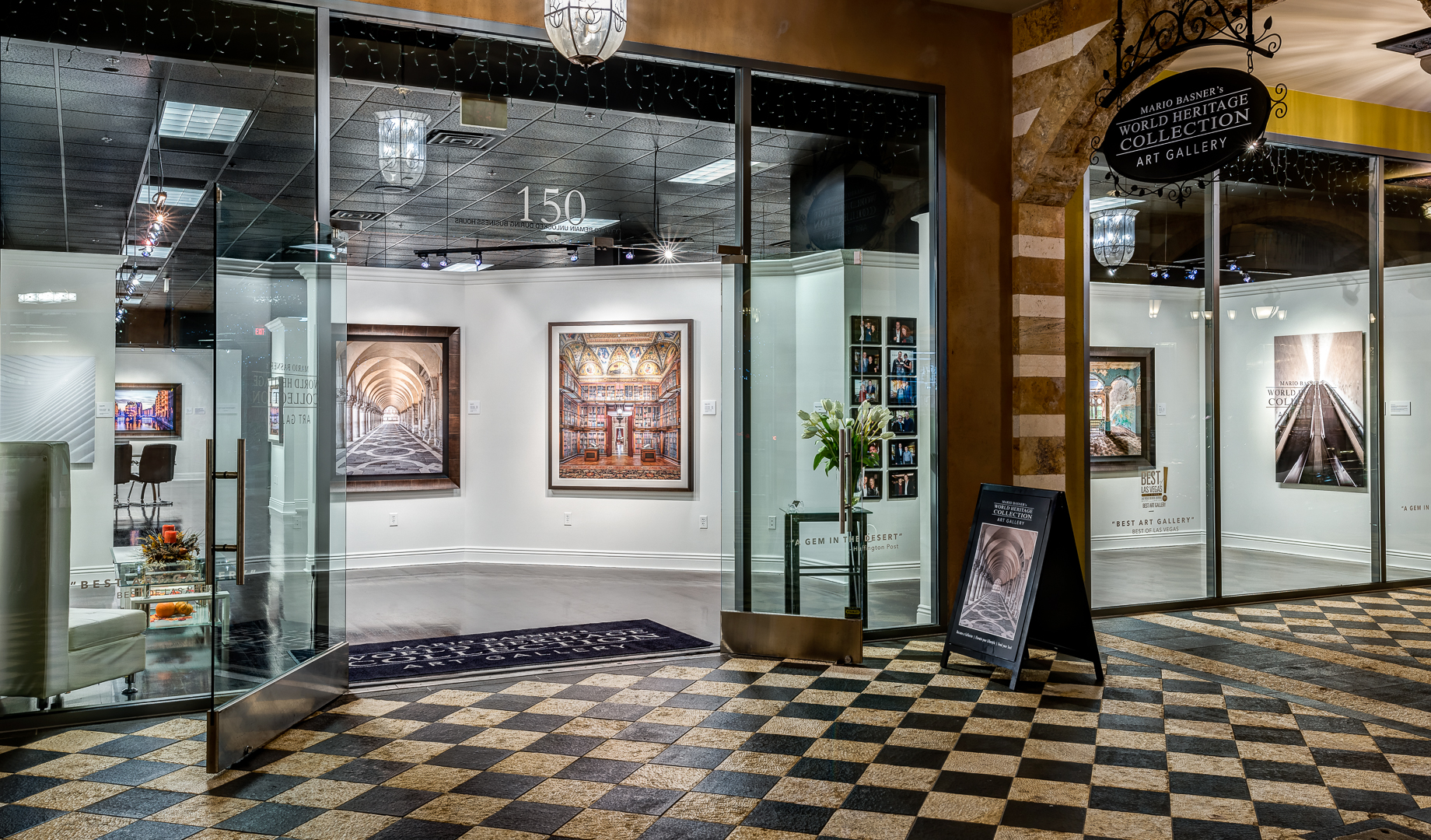
Windowfront of Mario Basner’s World Heritage Collection Art Gallery in Las Vegas Nevada.
MB: Generally speaking, everything in this gallery depicts architecture with purpose, you could say. These are extraordinary environments that have a very significant history. A lot of them are quite historic. All of them have a very interesting… So, there’s a lot of merit and a lot of story that, again, plays into the level of introspective. The rich experience that you can have when you engage with these environments.
One of my latest themes is an ongoing series of libraries. It’s primarily historic libraries, but there’s also a couple of very contemporary ones in the series now. This is an ongoing and growing series … And I choose this thematic because of the inspirational qualities of the environment. So, I’m actually not a big reader. So, for me, there’s not so much about the books as it is about the effect that those type of historic environments had on me growing up in Europe. And to me, when I grew up around history, it changed who I was able to become later in life, and the process of how I perceived the world around me. And it certainly gave me a different perspective on being grounded on my value system. So, it really affected and kind of opened my future for me. I always say that libraries are not just places where we might get educated. These are places where dreams are born. And that is certainly true in my case, and that’s why I’m very attached to — and very much in love with — this environment. I literally feed my soul every time.
We also have a brand-new series that was just released about which is based around the century -old aging cellars of earlier the 13th Cognac in France, which is absolutely stunning. This material is unbelievable. I was actually personally invited to capture these environments, which was a big privilege. It’s been a very long time since something like this was done. So, this is really material that you cannot find anywhere else in the world. It really transports again the audience into these environments which are not only very iconic, but they’re all just profoundly fascinating. You get to explore these historic cellars that you ordinarily would not be able to set for them. And the libraries extraordinary environments. They’re treasures.
VLM: And can you give me some examples of those libraries?
MB: We could start with, one in Dublin, very famous gallery. This library is literally the pride of the country, an extraordinary environment, and very famous as well. Then you have the Morgan Library in New York City, which was JP Morgan’s private library. It is now a museum, a significant piece of American history.
The George Peabody Library in Baltimore, also very significant piece of American history. We have Almont Abbey. It’s an attention monastery library in Austria. It’s the largest monastery library in the world.
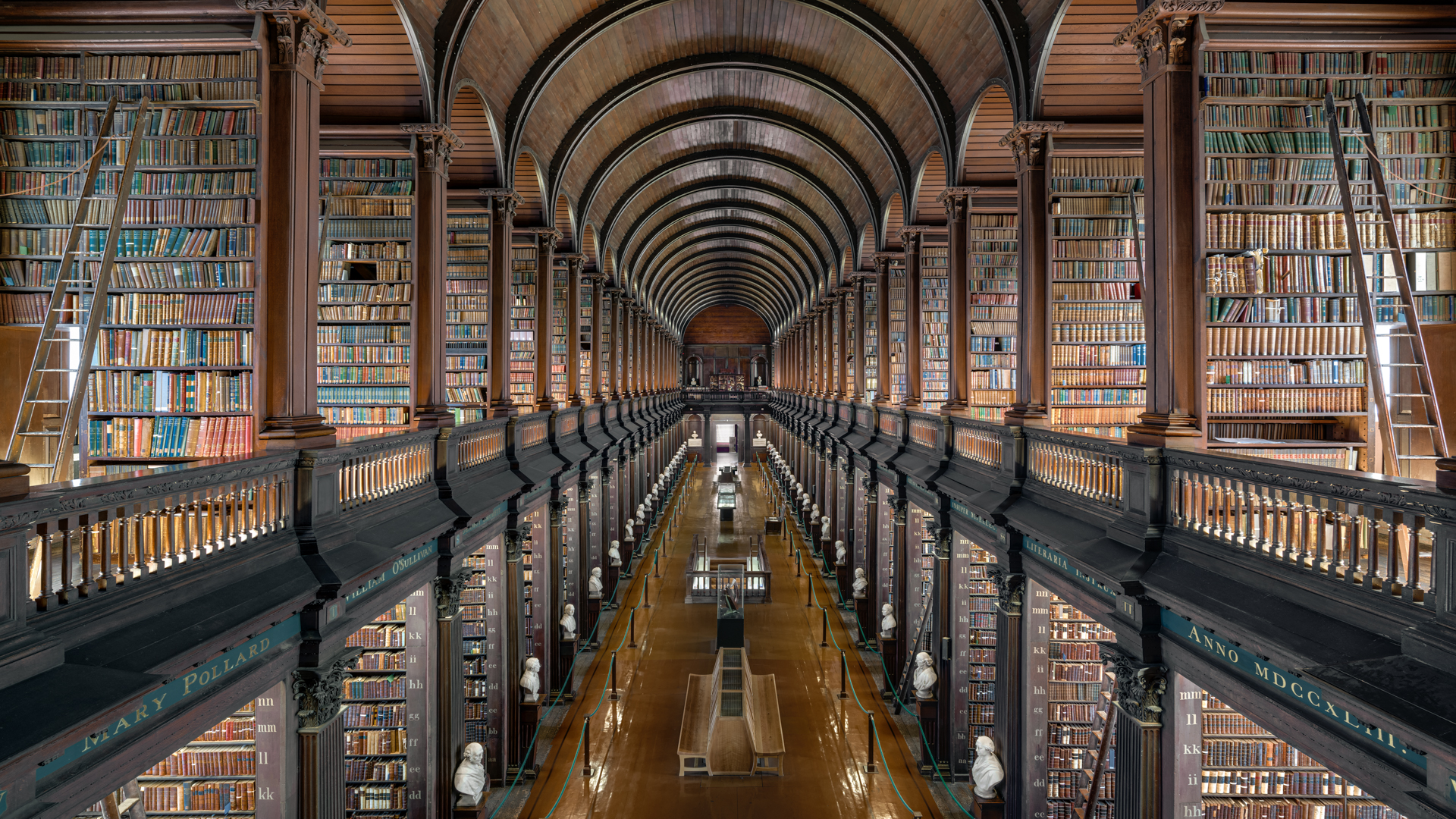
Architectual Portrait of Trinity College Library Long Room in Dublin Ireland by Las Vegas artist Mario Basner
VLM: How did you come up with the inspiration and the idea for the library collection?.
MB: Yeah it’s an experience to be there. Actually, I like to capture the soul of the building if you will. The library was my second series, the first one that I really started with was a documentary series that I did on an abandoned 19th century hospital, it was built for treatment of tuberculosis in 1898. I believe we saw that series online. That was really my debut in the fine art domain and it was a series that was very important to me. That then led me to spending a significant amount of time to actually complete it, and really doing justice to what I found there. That was a moment where I found my own voice, you know, where I found my purpose and I inadvertently put myself in service of that. So, that is really where my signature style came from, that first series. The libraries where the second series that came to mind very quickly because of what I mean. Previously, the environments that hold a lot of meaning to me because they have helped me become more of a human being later in life. So, they have a lot more to offer than just, you know, being a pretty building or being a place to get educated in. They really open, they change their personality, especially for young people. They create an experience and an environment where the world is open to you. You know, it is not just about consuming information, it is about being inspired to become who you are capable of becoming later.
VLM: What part of Germany were you from ?
MB: Hamburg
VLM: And so how old were you when you immigrated here?
MB: 27 or 28 (years old).
VLM: What year did you visit the sanitorium?
MB: There were two visits starting in late 2013. The main project was done in 2014.
VLM: Why did you choose photography over, let’s say, if you were something like painting? Or, was it just all with a natural progression? It was a natural transition,
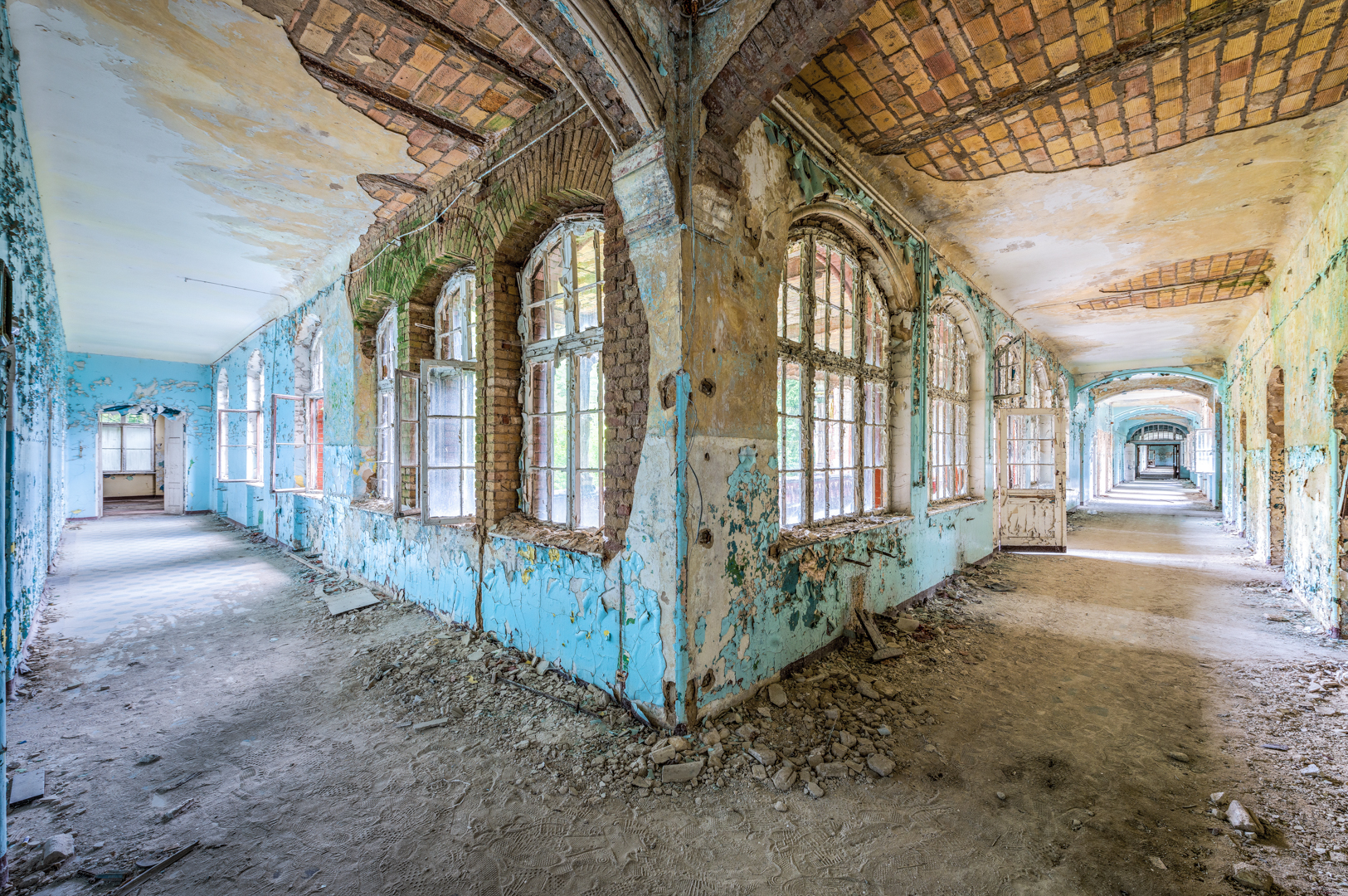 MB: I’ve engaged with photography for a number of decades, and I love the medium very much because it is real, it is not fictitious. But the subjects are real, and I love it very much. So, as for the libraries, I’m actually not a big reader. It’s not so much about the books as it is about the effect that those type of historic environments had on me growing up in Europe. I literally feed my soul every time. We also have a brand -new series that was just released about which is based around the century -old aging cellars of earlier the 13th Cognac in France, which is absolutely stunning. This material is unbelievable. I was actually personally invited to capture these environments, which was a big privilege. It’s been a very long time since something like this was done.
MB: I’ve engaged with photography for a number of decades, and I love the medium very much because it is real, it is not fictitious. But the subjects are real, and I love it very much. So, as for the libraries, I’m actually not a big reader. It’s not so much about the books as it is about the effect that those type of historic environments had on me growing up in Europe. I literally feed my soul every time. We also have a brand -new series that was just released about which is based around the century -old aging cellars of earlier the 13th Cognac in France, which is absolutely stunning. This material is unbelievable. I was actually personally invited to capture these environments, which was a big privilege. It’s been a very long time since something like this was done.
So, this is really material that you cannot find anywhere else in the world. It really transports again the audience into these environments which are not only very iconic, but they’re all just profoundly fascinating. You get to explore these historic cellars that you ordinarily would not be able to set for them.
VLM: And you know what I know we kind of touched on this a little bit before, but if you’re you know your future plans beyond whether you might open up other art galleries what could we look forward to for you know the see next from Mario Basner?
MB: There will probably a book at some point, I think. I am engaged in a lot of international exhibitions. I showed them different exhibitions.
VLM: And, on your collection on the sanitarium: How did you know about that? What was your inspiration for that particular subject ?
MB: You know it’s fair to say that particular location found me. I became aware of it through a social media article, and I was found myself very compelled to visit and document the site which happened later that year. It became possible to do that. And as I was going, as I actually entered those buildings, something just really struck a nerve. I did not know what it felt like. And, it was a very humbling experience. It was a very profound experience. And, it really changed my perception of the world around me and on my own. I rediscovered my own value system, you could say. I found myself and my purpose in the process. So, that really inspired everything else that I did from that point forward.
Valerie Miller is a Las Vegas Valley-based award-winning journalist. She can be reached at (702) 683-3986 or valeriemusicmagic@yahoo.com.

Leave a Comment